
|
Sale 114
The New York Sale
| Lot |
Photo |
Description |
Bidding |
Lot 292 |
 |
Brittany. Francois I (1442-1450). Gold Cavalier d'or, undated, 3.23g (Rennes). Armored duke on horseback galloping right with shield and sword raised. Rev. Cross tréflée with ermine in angles, all within an angled polylobe (Fr 95; Dup 318). In NGC holder graded AU 55. A well struck and deeply toned example of this charming medieval motif. Value $3,500 - UP
Duke François II of Brittany (not to be confused with the French king of the same name) spent the bulk of his reign defending his semi-independent duchy from encroachment by the neighboring Kingdom of France. In 1465, he joined other dukes in the League of the Public Weal as a means of opposing the centralizing policies of Louis XI, but this alliance collapsed in 1477 after the fall of Charles the Bold and the absorption of Burgundy-the most powerful of the duchies-into France. After the death of Louis XI, François II attempted to preserve the independence of Brittany by forming alliances with the Duke of Orléans, the Count of Angoulême, and the Holy Roman Emperor against Anne of France, the daughter of Louis XI who ruled as regent for the young Charles VIII. Together, in 1485, François II and his allies embarked upon a series of conflicts with France collectively known as the Mad War. Unfortunately, the Duke of Brittany was defeated at the Battle of Saint-Aubin-du-Cormier on July 8, 1488, and was forced to become a vassal to the French king under the terms of the Treaty of Sablé (August 20, 1488). François II fell from his horse shortly thereafter and died. He was succeeded by his daughter, Anne of Brittany, who was forced marry to Charles VIII thereby guaranteeing that upon her death Brittany would be fully absorbed into the Kingdom of France.
The introduction of the cavalier d'or ("gold knight") denomination is variously attributed to François I or more likely François II as a means of financing wars and diplomacy to preserve the autonomy of the duchy. It was so-named for the obverse depiction of the duke charging into battle on horseback. Heraldic ermine is prominent on the duke's shield, the caparison of the horse as well as in the reverse design because it was an emblem of the duchy. Since the 1380s the Château de l'Hermine (Ermine Castle) had been the primary residence of the dukes of Brittany. François II himself had been born within its walls.
View details and enlarged photos
|
|
Lot 293 |
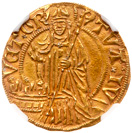 |
Lorraine. Duke René II (1473-1508), Gold Florin, undated. St. Nicholas holding staff. Rev. Arms of Hungary, Naples, Jerusalem, Aragon, Anjou and Bar, in center, arms of Lorraine (Fr 139). In NGC holder graded AU 53, sharply struck example. Rare. Value $14,000 - UP
The obverse of the present florin depicts St. Nicholas, the Bishop of Myra (270-342), who is perhaps best known for his subsequent association with Santa Claus. Like his red-suited alter ego, the St. Nicholas also had a reputation for gift giving and for his care of children. He is famously said to have secretly given money to a destitute man to provide for his three young daughters. The florin type, however, represents a far more dramatic event in the legendary life of the saint. Here, St. Nicholas stands in his full bishop's attire blessing three small children seated and praying on top of a barrel. According to an apocryphal tradition, the saint discovered that an evil butcher had killed three children and pickled their bodies in brine with the intention of selling them later as pork during a famine(!). St. Nicholas, imploring the mercy of God, is then reported to have raised the children back to life. It is this moment, when the children have emerged alive again from the pickling barrel, that is represented on this coin.
More than a century after his death, the church in Asia Minor where St. Nicholas had been bishop was rebuilt on a grander scale by the Emperor Theodosius II. The body of the former bishop was interred in a sarcophagus beneath the church, which was then renamed the Church of St. Nicholas. Every year his relics were said to exude a liquid with the scent of rose water called "myrrh" by the faithful. This liquid was widely believed to have miraculous properties. In 1087, Italian sailors from Bari stole the relics and "translated" them to their home town. Two years after this so-called "holy robbery," Pope Urban II inaugurated the Basilica of Saint Nicholas at Bari. Although the removal of St. Nicholas' relics remains a sore point with the Greek Orthodox Church to this day, it was assumed by Catholics that the saint cannot have been overly upset about it since the relics have reportedly continued to produce "myrrh."
It is now in his role as patron saint of Bari that St. Nicholas appears on this florin. Bari was an important part of the Kingdom of Naples (i.e., the peninsular territory of the Kingdom of Sicily after its separation from the island of Sicily in 1282), which René II ruled from 1493 to 1508. The obverse legend, however, identifies René II only as King of Sicily, completely ignoring the division between the island and peninsular territories and that contemporary kings from the Spanish House of Trastámara actually reigned in Sicily proper.
View details and enlarged photos
|
|
Lot 294 |
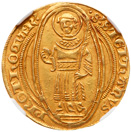 |
Metz. Free City. Gold Florin, undated. St. Stephen holding palm branch. Rev. Two-part city arms in circle of six arches (Fr 164). In NGC holder graded XF 45. Value $1,250 - UP
Originally the capital of the Carolingian kingdom of Lotharingia in the ninth century, Metz was ruled by a series of prince-bishops in the tenth and eleventh centuries. The power of these ecclesiastical rulers was broken in 1189, when Metz received the status of an Imperial Free City of the Holy Roman Empire. In response, the prince-bishops removed themselves to nearby Vic-sur-Sielle and the burgesses of Metz declared a republic. The new Republic of Metz was governed by an oligarchy of 13 to 21 aldermen under an elected head alderman and advised by a house of burgesses. Under this government the city grew wealthy from trade and especially international banking. The wealth of the city often made it a target for attack by neighboring rulers in the fourteenth and fifteenth centuries. In 1324, Metz successfully defended itself against the Dukes of Luxembourg and Lorraine; in 1363 and 1365, against the English brigands under the command of Arnaud de Cervole; in 1444, against Duke René of Anjou and King Charles VII of France; and in 1473, against Duke Nicholas I of Lorraine.
Metz struck its first gold florins in 1439-1450 as a reflection of both the city's wealth and its need to finance the defense of the republic against its jealous neighbors. The obverse features St. Stephen the patron saint of Metz. He is shown within a mandorla and holding a stone and palm branch to signify his status as the first Christian martyr. The palm represents his martyrdom as a victory of faith and the stone represents the means of his death. The reverse depicts the arms of the city.
Ex Terner Collection by Private Treaty.
View details and enlarged photos
|
|
Lot 295 |
 |
Orange. Prince Raymond III (1335-1340) or Raymond IV (1340-1393). Gold Florin, undated. St. John the Baptist standing. Rev. Large fleur-de-lis (Fr 189). In NGC holder graded MS 62. Value $500 - UP
In 1166 the County of Orange was elevated to the status of a principality by the Holy Roman Emperor Frederick I Barbarossa in order to strengthen the power of the pro-Imperial House of Baux against the pro-French faction in the disintegrating Kingdom of Burgundy. Orange was ruled by scions of the House of Baux until 1393, when the Principality of Orange devolved upon the House of Châlon-Arlay.
This attractive gold florin belongs to a wider series of imitations of the popular Florentine denomination struck by other European states in the fourteenth century. It features identical types to those found on the Florentine florin. John the Baptist, the patron saint of Florence appears on the obverse with an encircling Latin legend identifying him and a large fleur-de-lis appears on the reverse. The only feature that distinguishes this coin from a true Florentine florin is the abbreviated reverse legend (R DI G P AUR) which is translated as "Raymond, by the grace of God, Prince of Orange." The Raymond in question has been variously identified as Raymond III, Raymond IV, or Raymond V, all of whom were relatively obscure sovereign princes of Orange in the second half of the fourteenth century before the rise of the House of Châlon-Arlay.
Ex Terner Collection by Private Treaty.
View details and enlarged photos
|
|
Lot 296 |
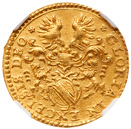 |
Strasbourg. City. Gold Ducat (1650). Helmeted arms with lion supporters. Rev. Four line inscription within wreath (Fr 237; KM 424) In NGC holder graded MS 62. Value $2,500 - UP
The medieval town of Strasbourg grew out of the ancient Roman military camp first established at Argentoratum in 12 BC. In 923, Strasbourg passed under the authority of the Holy Roman Empire when the Duke of Lorraine swore fealty to the Ottonian Holy Roman Emperor Henry I. Strasbourg was an important commercial center ruled by powerful prince-bishops, but over time the ecclesiastical rulers came into conflict with the burghers over their rights and obligations. At last, in 1262, the burghers of Strasbourg, with support from Count Rudolf von Habsburg, made war on their ruler, Walter von Geroldseck, and forced him to flee. Strasbourg subsequently received the status of an Imperial Free City. In 1332, a political revolution in Strasbourg resulted in the reorganization of the city as a republic under the leadership of a broadly-based city council that included members of many trade guilds. Strasbourg prospered from the fourteenth to the seventeenth century and gained fame for its cathedral, which at the time was the tallest building in the world, and for its important role in the development of modern printing using movable type. Strasbourg adopted Lutheranism in the 1520s but managed to remain aloof from the devastating religious conflicts of the Thirty Years' War (1618-1648). However, the city's strategic location on the Holy Roman Empire's frontier with France made it a target for Louis XIV. By 1648 almost the entirety of Alsace had fallen to the Sun King except for Strasbourg. The city held out as an independent republic of the Empire until 1681, when the French king marched into Strasbourg unopposed and declared its annexation to France.
The present gold ducat features a grandiose depiction of Strasbourg's coat-of-arms featuring the simple shield blazoned with the city's arms supported by two lions and surmounted by a magnificent tilting helm adorned with eagle's wings. This form of helmet was reserved for arms granted to burghers in the heraldry of the Holy Roman Empire. The reverse Latin inscription identifies the value of the coin as a ducat but employs the old name of Argentoratum rather than a Latinized form of Strasbourg to name the city. This undated coin is usually dated to c. 1650, before the capture of the city by Louis XIV, but the prominent fleur-de-lis-the badge of the kingdom of France-above the reverse legend may perhaps suggest a post 1681 date.
Ex Terner Collection by Private Treaty.
View details and enlarged photos
|
|
Lot 297 |
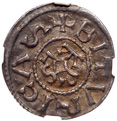 |
Charlemagne (768-814) Silver Denier, undated. Bourges mint. Karlus monogram within beaded border, BITURICAS. Rev. Short cross pattee, +CARLVS REX FR (Roberts 956). In NGC holder graded XF 45, Rare. Value $4,000 - UP
View details and enlarged photos
|
|
Lot 298 |
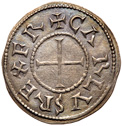 |
Charles the Bald (843-877). Silver Denier (1.72g). Paris mint. + CARLVS RE +FR, cross pattee. Rev. + PARISII CIVITAS, temple portico (MG 827). In PCGS holder graded AU 50. Value $500 - UP
Under the terms of the Treaty of Verdun (843), Charles II "the Bald" and his warring older brothers, Louis the German and Lothair I, formally divided the Carolingian Frankish kingdom between them. Charles II became the king of West Francia (roughly equivalent to modern France), but made himself so unpopular that when Louis invaded his kingdom in 858, Charles was unable to raise an army and had to flee to Burgundy. He was only able to return to the throne after the bishops of West Francia refused to crown Louis the German as king. The reign of Charles the Bald was troubled not only by conflict with his brother, but by frequent revolts in Aquitaine and Brittany as well as by the depredations of the Vikings. The latter actually besieged and sacked Paris in 845 and compelled Charles II to pay significant sums to purchase safety from the raiders on later occasions. The Viking threat to Paris and other settlements in his kingdom finally led Charles to improve the mobility of his army with the addition of the cavalry units that later evolved into the French chivalry of the high Middle Ages. He also ordered the erection of fortified bridges on all rivers in order to more easily defend them against the Norseman.
View details and enlarged photos
|
|
Lot 299 |
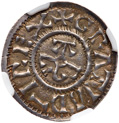 |
Charles the Bald (843-877). Silver Denier, undated (1.45g). Rennes mint. Karolus monogram; + GRATIA D-I REX, Rev. Cross; +HREDONISCIVITAS. (MG 1045; Roberts 1423). In NGC holder graded AU 58, sharply struck and toned. Value $750 - UP
Despite his traditional description as "the Bald", there is very little evidence to indicate that Charles II actually had any problems with his hairline. In the surviving sculptural, engraved, and painted representations of this Carolingian king he is always depicted with a full head of hair. This has led to much speculation as to the true meaning of his nickname. It has been variously suggested that it was used ironically because Charles II was actually a very hairy man or makes mocking reference to the fact that he initially had no kingdom of his own under his father, whereas his brothers had been ruling as sub-kings under Louis the Pious for years. Following this line of explanation, in 843 West Francia became Charles' toupee, covering his previous unsightly royal baldness. After years of struggle, in 858 Charles exchanged this toupee for an even grander wig when he was crowned Holy Roman Emperor as a successor to his nephew Louis II. However, Charles' brother, Louis the German, who was a rival candidate for the imperial crown attempted to trim his locks by devastating large swathes of West Francia. When Louis died in 876, Charles II moved to seize his brother's domains in East Francia, but was repulsed by the nobles. He fell ill the following year, and died while crossing the Alps from Italy to West Francia. Charles the Bald was hastily buried at the Abby of Nantua in Burgundy, reportedly because his attendants could no longer withstand the stench of his decaying corpse. The great hairpiece of West Francia was thence inherited by Charles' son, Louis the Stammerer.
View details and enlarged photos
|
|
|
|